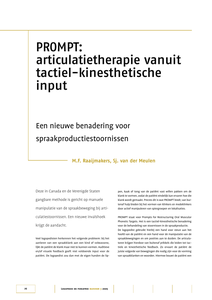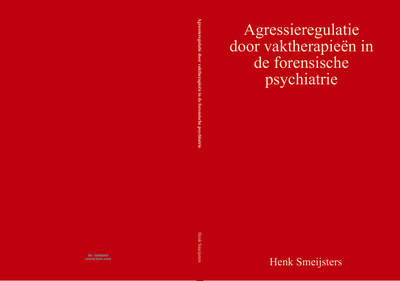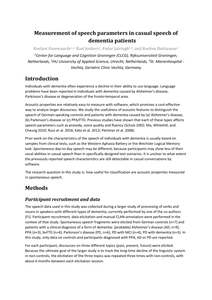Dysarthritic Parkinson speech is characterised by impairment of expressive linguistic prosody, even making it difficult to understand. While rigidity and bradykinesia can be held responsible for a general decline in speaking ability, the origin of prosodic impairment must be seen in the light of the accompanying impairments of receptive prosody such as the inability to recognize intonational meaning and make lexical distinctions based on stress contrasts . The stimulating effect of music on motor coordination in afflicted patients suggests that music might have a similar effect on vocal behavior. It could be hypothesized that the singing of Parkinson patients might remain relatively unaffected by the disease. In this study, vocal improvisation was used to compare the singing of Parkinson patients with that of healthy controls, matched for age and gender. When F0 , range, mean absolute slope, and tempo were contrasted, Parkinson patients did not differ significantly from controls.
DOCUMENT

Sinds de invoering van de Wet Passend onderwijs zijn leerkrachten in het regulier primair onderwijs verantwoordelijk voor het aanbieden van een passend onderwijsaanbod voor alle kinderen. Hiertoe behoren ook leerlingen met een autismespectrumstoornis (ASS). Kinderen met ASS hebben onder andere moeite met sociale interactie. Omdat onduidelijk is welke ondersteuningsvormen toepasbaar zijn in de klas en passen bij de specifieke behoeftes van ASS-leerlingen, richt deze thematische overzichtsstudie zich op de volgende onderzoeksvraag: Wat is er in de literatuur bekend over de ondersteuningsbehoeftes van kinderen met een autismespectrumstoornis en welke ondersteuningsvormen uit effectieve interventies gericht op het verbeteren van de sociale interactie op school sluiten aan bij deze ondersteuningsbehoeftes? Om tot een selectie van relevante literatuur te komen zijn twee search strings opgesteld waarmee in diverse databases is gezocht: één gericht op ondersteuningsbehoeftes en één op ondersteuningsvormen. De titels en abstracts van 994 artikelen zijn gescreend op basis van vooraf opgestelde inclusiecriteria (algemene criteria, zoals doelgroep én inhoudelijke criteria, zoals focus op ASS). De overgebleven artikelen zijn met leesschema’s gericht op de methode en ondersteuningsbehoeftes en -vormen, geanalyseerd. Hierbij zijn de kenmerken van ASS, zoals gedefinieerd in de DSM-V, gehanteerd: sociaal-emotionele wederkerigheid, non-verbale communicatie en relaties. 68 artikelen zijn uiteindelijk opgenomen in ons overzicht.Op het gebied van sociaal-emotionele wederkerigheid zijn de volgende behoeftes gevonden: sociale vaardigheid ontwikkelen, wederkerige interactie stimuleren, sociaal-emotioneel begrip vergroten en taalvaardigheid verbeteren. Met betrekking tot non-verbale communicatie kwam naar voren dat het nodig is om non-verbaal gedrag en de integratie van non-verbaal gedrag met verbaal gedrag te verbeteren. Op het gebied van relaties kwam naar voren dat het nodig is om te ondersteunen bij: het ontwikkelen en verbeteren van relaties, joint engagement/spel en sociaal gewenst gedrag. Meisjes en cognitief vaardige leerlingen en hun specifiekere ondersteuningsbehoeftes vallen minder op. Ook leerlingen met bijkomende problemen die meer op voorgrond liggen (bijvoorbeeld een angststoornis) en hun specifiekere ondersteuningsbehoeftes kunnen minder opvallen. De interventies die in de literatuur zijn gevonden zijn sociale vaardigheidstrainingen en interventies waarbij óf de leeftijdsgenoten, óf volwassenen óf beide doelgroepen getraind worden. Binnen deze interventies worden diverse ondersteuningsvormen genoemd en/of gecombineerd: directe instructie waarbij een vaardigheid of gedrag wordt uitgelegd, aanwijzingen worden gegeven, goed gedrag wordt aangespoord en bekrachtigd; video-modeling waarbij een sociale situatie wordt voorgedaan met behulp van een video of game; modeling door volwassenen of medeleerlingen waarbij vaardigheden worden voorgedaan; modeling door zichzelf waarbij kaarten worden gebruikt ter herinnering aan de geleerde vaardigheden; social stories waarbij specifiek sociaal gedrag met de gewenste reactie wordt omgeschreven.De interventies richten zich meestal niet op één enkele ondersteuningsbehoefte, maar op meerdere. De meeste interventies uit onze selectie die zich richten op wederkerige sociaal-emotionele interactie blijken sociale vaardigheidstrainingen te zijn. Hierbij is een veel voorkomende ondersteuningsvorm directe instructie. Ook interventies waarbij de leeftijdsgenoten worden getraind om gedrag voor te doen, komen veel voor. Wat betreft non-verbale communicatie blijken sociale vaardigheidstrainingen gericht op emoties, gebaren en richten van de blik het meeste voor te komen. Hierbij wordt modeling door volwassenen, medeleerlingen en/of video ingezet. De meeste interventies die zich richten op relaties zijn interventies waarbij medeleerlingen getraind worden en een sociaal netwerk rondom de ASS-leerling wordt gevormd. Vormen van ondersteuning zijn modeling door leeftijdsgenoten die bijvoorbeeld laten zien hoe je kunt spelen. Opvallend is dat de interventies niet gericht zijn op specifiekere ondersteuningsbehoeftes van doelgroepen die minder opvallen, zoals meisjes. Daarnaast richt ondersteuning zich met name op klachten en minder op krachten. Vanwege de inclusie in het regulier onderwijs van ASS-leerlingen is het van belang om de ondersteuning af te stemmen op de unieke behoeftes en de talenten van het individu in de natuurlijke setting van de klas.
DOCUMENT

PROMPT is a tactile-kinesthetic approach for assessment and treatment of speech production disorders. PROMPT uses tactile-kinethetic cues to facilitate motor speech behaviors. Therapy is structured from basic motor speech patterns with much tactile-lkinesthetic cueing, towards complex motor speech activities with less cueing. This article describes the purpose and contents of PROMPT assessment and therapy.
DOCUMENT

Geleide Audiomotor Exploratie (GAME) is een innovatieve lesmethode waarmee slechthorenden met een Cochleair Implantaat (CI) piano kunnen leren spelen zonder muzieknotatie. Het doel van GAME is om door actief muziek te maken, transfereffecten van muziek- naar het spraakdomein te realiseren. Hierdoor kunnen CI-gebruikers zowel muziek als spraak beter gaan verstaan. Hoewel GAME ontworpen is om in de gewone lespraktijk gebruikt te worden, vereist het lesgeven met GAME nieuwe kennis en vaardigheden van pianodocenten. Dit onderzoek is daarom gericht op het ontwikkelen van instructiemateriaal en scholing voor het lesgeven met GAME. Zes pianodocenten en een ‘critical friend’ deden mee aan dit onderwijskundig ontwerp onderzoek. Tijdens het onderzoek zijn de lesmethode en het lesmateriaal aangepast en doorontwikkeld. De uitkomsten van het onderzoek laten zien dat docenten een ‘totaalpakket’ nodig hebben: (1) een handleiding gecombineerd met (2) demonstratie video’s, (3) lesmateriaal en voorbeeld lesplannen, (4) workshops en (5) collegiaal overleg. Deelnemende docenten vonden vooral de video’s gecombineerd met uitleg belangrijk omdat GAME totaal anders is dan traditionele lesmethodes. Het onderzoek heeft geleid tot suggesties voor implementatie in lespraktijken en Hoger Beroeps Onderwijs en aanbevelingen voor mogelijke toepassingen van GAME bij andere doelgroepen, zoals leerlingen met leerproblemen.
DOCUMENT

In dit artikel wordt het concerpt 'participatiestructuur' geïntroduceerd en als een relevant concept voor de beschrijving van de variatie in manieren waarop gesprekken in de klas gevoerd worden, nader toegelicht. Tevens wordt duidelijk gemaakt hoe de keus voor bepaalde participatiestructuren, die zichtbaar zijn in het gehanteerde taalgebruik van leerkrachten en leerlingen, leerlingen op een bepaald type toekomstige samenleving oriënteren. In dat verband wordt ervoor gepleit om dialogische participatiestructuren en discussie-structuren, die ruimte en rechten voor leerlingen impliceren, te bevorderen in de klas en in lerarenopleidingen.
DOCUMENT

Het document beschrijft allereerst reeds uitgevoerd onderzoek naar het gebruik van vaktherapieën bij agressieregulatie in de forensische psychiatrie.
DOCUMENT

Logopedisten en klinisch linguïsten onderzoeken de taalontwikkeling van jonge kinderen met een vermoedelijke of al vastgestelde taalontwikkelingsstoornis. Ze onderzoeken ook de taalvaardigheid van personen met afasie. Naast gestandaardiseerde tests worden samples spontane taal geanalyseerd. Hiervoor worden uitingen ontlokt aan de patiënten via vaste protocollen. De sessies worden opgenomen, getranscribeerd en vervolgens grammaticaal geanalyseerd. Bij de grammaticale analyse wordt bepaald welke soorten constructies en fouten voorkomen en in welke mate, en dit wordt vergeleken met een norm. Taal- en spraaktechnologie (TST) kan er in prin-cipe aan bijdragen om het proces van transcriptie en grammaticale analyse efficiënter te maken en mogelijk zelfs om de kwaliteit van de assessments te verhogen. In dit artikel richten we ons op de mogelijkheden van TST voor de analyse van kindertaal.
LINK
From the article: "Individuals with dementia often experience a decline in their ability to use language. Language problems have been reported in individuals with dementia caused by Alzheimer’s disease, Parkinson’s disease or degeneration of the fronto-temporal area. Acoustic properties are relatively easy to measure with software, which promises a cost-effective way to analyze larger discourses. We study the usefulness of acoustic features to distinguish the speech of German-speaking controls and patients with dementia caused by (a) Alzheimer’s disease, (b) Parkinson’s disease or (c) PPA/FTD. Previous studies have shown that each of these types affects speech parameters such as prosody, voice quality and fluency (Schulz 2002; Ma, Whitehill, and Cheung 2010; Rusz et al. 2016; Kato et al. 2013; Peintner et al. 2008). Prior work on the characteristics of the speech of individuals with dementia is usually based on samples from clinical tests, such as the Western Aphasia Battery or the Wechsler Logical Memory task. Spontaneous day-to-day speech may be different, because participants may show less of their vocal abilities in casual speech than in specifically designed test scenarios. It is unclear to what extent the previously reported speech characteristics are still detectable in casual conversations by software. The research question in this study is: how useful for classification are acoustic properties measured in spontaneous speech."
MULTIFILE

Abstract In this paper several meaningful audio icons of classic arcade games such as Pong, Donkey Kong, Mario World and Pac-Man are analyzed, using the PRAAT software for speech analysis and musical theory. The analysis results are used to describe how these examples of best practice sound design obtain their meaning in the player's perception. Some aspects can be related to the use of tonal hierarchy (e.g. Donkey Kong and Mario World) which is a western culture related aspect of musical meaning. Other aspects are related to universal expressions of meaning such as the theory of misattribution, prosody, vocalization and cross-modal perceptions such as brightness and the uncanny valley hypothesis. Recent studies in the field of cognitive neuroscience support the universal and meaningful potential of all these aspects. The relationship between language related prosody, vocalization and phonology, and music seems to be an especially successful design principle for universally meaningful music icons in game sound design.
DOCUMENT
Analysis of spontaneous speech is an important tool for clinical linguists to diagnose various types of neurodegenerative disease that affect the language processing areas. Prosody, fluency and voice quality may be affected in individuals with Parkinson's disease (PD, degradation of voice quality, unstable pitch), Alzheimer's disease (AD, monotonic pitch), and the non-fluent type of Primary Progressive Aphasia (PPA-NF, hesitant, non-fluent speech). In this study, the performance of a SVM classifier is evaluated that is trained on acoustic features only. The goal is to distinguish different types of brain damage based on recorded speech. Results show that the classifier can distinguish some dementia types (PPA-NF, AD), but not others (PD).
DOCUMENT